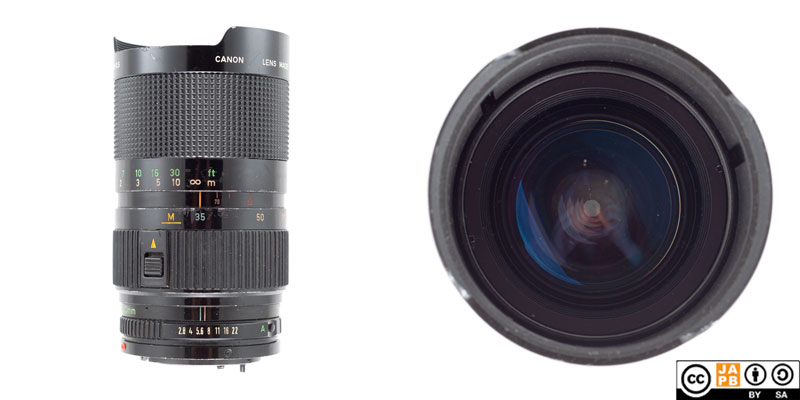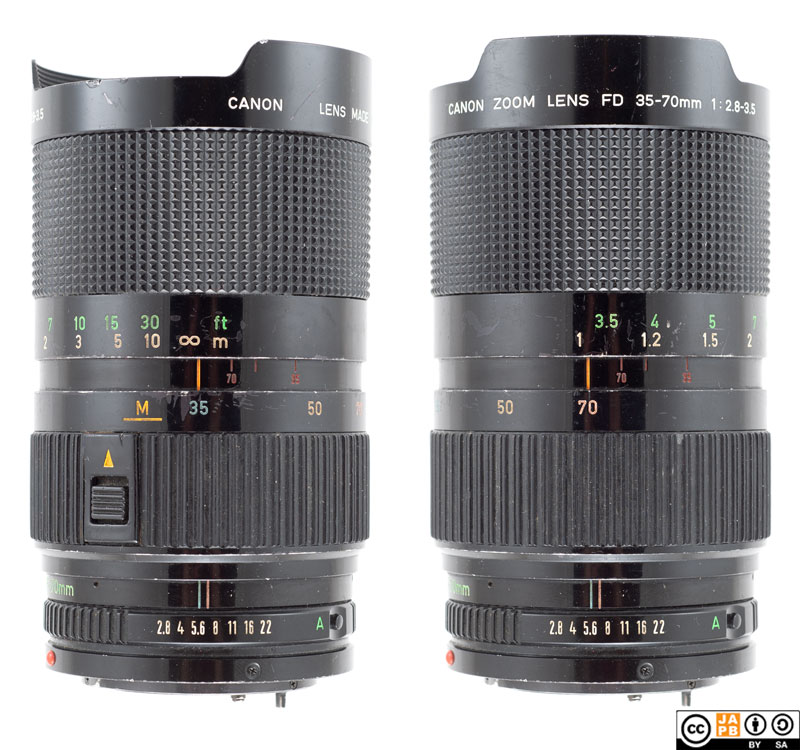Pekka Buttler, 02/2025

Specifications
The table below summarises the lens’ key specifications (measurements based on pictured sample):
| Brand: | Canon | Lens name | Zoom Lens FD 35-70 mm 1:2.8–3.5 |
| Focal length(s)1 | 35-70 mm | Angle-of-view2 | 24°–12° |
| Maximum Aperture | f/2.8–3.5 | In Production | 1979–1987 |
| Lens mount | Canon FDn | Subfamily (if applicable) | N/A |
| Length3 | 122,2 mm | Diameter4 | 69,0 mm |
| Filter ring diameter | 58 mm | Weight | 541 grams |
| Lens element count | 10 | Lens group count | 10 |
| Aperture blades (S/R/C)5 | 8 S | Focus throw | 140 ° |
| Minimum focusing distance (measured) | 1 m@35mm; 88cm@70mm 32cm (macro mode) | Maximum magnification (measured) | 1:11,8 (@70mm) 1:5 (macro mode) |
| Has manual aperture ring | YES | Has Manual focus ring | YES |
| Aperture mechanism type | Automatic | Aperture click stops 6 | 2.8•4•5.6•8•11•16•22 |
Further notes:
• This lens is Canon’s second generation 35–70/2.8–3.5 lens. The first generation was introduced as the Canon FD 35-70/2.8–3.5 in 1973 and was at the time the first standard zoom starting at the wide focal length of 35 mm.
• This lens is a two-ring zoom lens, with the rearmost ring controlling the zoom (focal length) and the frontmost ring controlling focusing distance.
• The lens looks like it would be using an internal zooming and internal focusing approach. In fact, both zooming and focusing change the length of the lens, but it all happens deep within the hood of the lens. This means that (outwardly) the lens’ shape stays the same while zooming and focusing.

Right: Canon FDn 35–70 mm f/2.8–3.5 zoomed to 70 mm and focused to just short of MFD (where the hood’s petals align with the frame)
• The entire front of the lens rotates on focusing. Interestingly, the filter threads on the inner barrel rotate as well.
• The lens has a rather odd arrangement where the (rotating) front barrel of the lens doubles as a shallow petal-shaped lens hood. Weirdly, those petals align with the shape of the frame only at a focusing distance of a few centimetres long of MFD.
• The lens’ minimum focusing distance is roughly a metre (depending on focal length), which is rather modest and might limit the lens’ usability. To compensate, the lens offers a macro mode at the wide end, that allows focusing all the way down to 32 centimetres.
• The lens is nowhere near parfocal.
• While the 10-element construction might have been ambitious in 1973, in 1979 this lens starts to be a bit dated. However, with its bright maximum aperture, this lens was clearly intended as a professional’s tool.
• Canon started it’s famous (Luxury) L-line of lenses in 1979. It is significant that this lens was not awarded that status while the 24-35/3.5L (also introduced 1979) takes the honour of being the first L-line zoom.
History of Canon FDn lenses
Feel free to browse the JAPB article on the Canon FDn mount for all the details. Below is an outline of the position of the Canon FD mount in Canon’s development trajectory:
• 1959–1963: R-mount. Canon’s first SLR lens mount. Breech lock-type mount with aperture semi-automation (camera is able to stop down lens for taking the shot, but lens needs to be opened up by user action) .
• 1964–1969: FL-mount. Breech-lock type mount, physically similar mount as Canon R-mount, but camera-to-lens communication linkages somewhat different. Cannot communicate selected aperture to body (stop-down-metering only).
• 1970–1978: FD-mount. Breech-lock mount. FD lenses compatible with FL-cameras and vice versa. Manual focus lenses that communicate aperture information to camera, hence opening the door for automatic exposure (both shutter priority and aperture priority possible)
• 1979–1986: new FD-mount (a.k.a. FDn). Bayonet mount, backwards compatible with FL and FD mounts. Otherwise, as FD mount.
• 1987–today: EF-mount. Electronically controlled autofocus lenses that use an internal focusing motor. Compatible with previous mount lenses only using an adapter with optics.
The era of the Canon FD and FDn mounts can be characterised by a gradual shift towards the ever-increasing use of plastics and lighter materials. In the chronology of this gradual shift:
• Chrome nose FD lenses (1971–1973) are solid metal (often brass), glass and (synthetic) rubber.
• Black nose FD lenses (1973-≈1975) are also metal, glass and rubber, but often 5-10% less heavy than chrome nose lenses.
• Late FD, (≈1975–1979) rubber is replaced by plastic and heavier metals are gradually replaced by lighter alloys
• With FDn lenses (1979–1987) this trend came to its natural conclusion as these lenses typically make extensive use of light alloys as well as, increasingly, plastics.
(In the EF era (1987 onwards) plastics fully take over)
A final, noteworthy aspect pertains to the S.C. and S.S.C. monikers found on some generations (Black nose and Late FD) Canon lenses: by the time of the introduction of the FDn mount Canon decided to do away with these markings. Hence, while FDn versions no longer sported the S.C. or S.S.C monikers, their coatings are always at least as good as that of their direct predecessor in the Canon FD line.
Related versions
In terms of optical designs, this lens has no clear predecessors or successors.
Adapting
This lens cannot be used natively on any current SLR or dSLRs. To use it in its native environment, you will need a Canon FD or FL-mount film body.
Thanks to being a fully manual lens (manual aperture, manual focus), the lens can be adapted to all mirrorless cameras using a suitable adapter. However, for the adapter to allow the lens to stop down, you will need an adapter that can be set to engage the FD lens’ aperture control lever.
Moreover, a large range of special adapters (helicoid adapters, tilt/shift adapters, speed boosters) for using Canon FD lenses on most mirrorless systems are available.
Using Canon FD lenses on dSLRs is a possibility, but is not problem free. Thanks to the relatively short flange focal distance of the Canon FD mount (at 42,0 mm, clearly shorter than that of any full-frame dSLR mount), any adapter will necessitate some corrective optics to achieve infinity focus.
Footnotes
- Focal length is (unless stated otherwise) given in absolute terms, and not in Full-frame equivalent. For an understanding of whether the lens is wide/tele, see ‘Angle-of-view’. ↩︎
- Picture angle is given in degrees and concerns the diagonal picture angle. Rule of thumb:
> 90 ° ==> Ultra-wide-angle
70–90 ° ==> Wide-angle
50–70 ° ==> Moderate wide-angle
40–50 ° ==> ‘Standard’ or ‘normal’ lens
20–40 ° ==> Short tele lens
10-20 ° ==> Tele lens
5-10 ° ==> Long tele lens
< 5 ° ==> Ultra-tele lens ↩︎ - Length is given from the mount flange to the front of lens at its shortest. ↩︎
- Diameter excludes protrusions such as rabbit ears or stop-down levers. ↩︎
- S=straight; R=rounded; C=(almost)circular at all apertures. ↩︎
- Numbers equal aperture values on aperture ring; • intermediate click; – no intermediate click. ↩︎